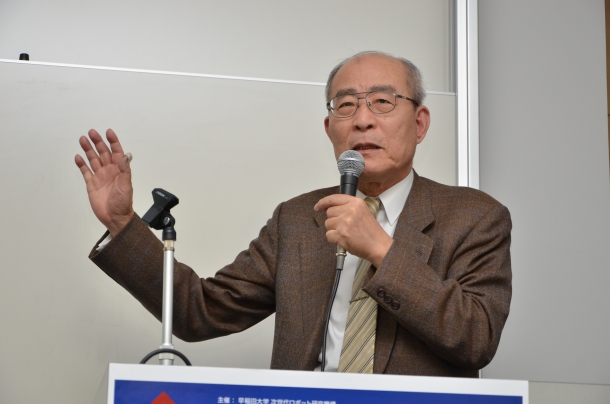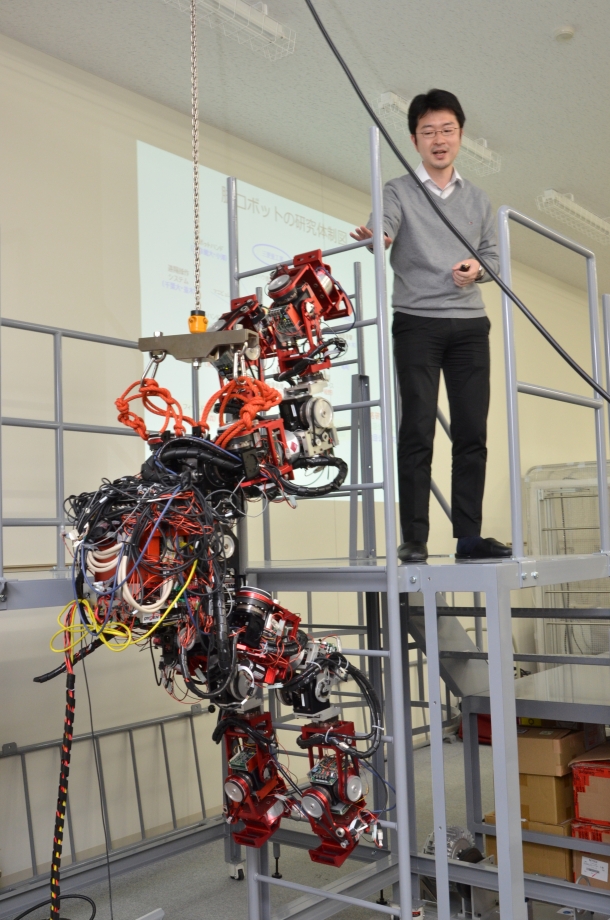For half a century, Waseda University has conducted robotics research to create robot technology that works with and supports people. To further promote cutting edge research, on March 2, 2015, the University established the Future Robotics Organization (Director Masakatsu Fujie), which houses three research project institutes and is grounded in the belief that “robots are machines made to support people.”
On January 16, the Future Robotics Organization kicked off its first symposium. Approximately 150 students, faculty, and guests attended.
University Vice President Shuji Hashimoto (Faculty of Science and Engineering) opened the symposium, saying, “Waseda University’s robotics research began in the late 1960s, spearheaded by Professor Ichiro Kato. Half a century has passed since then. Among the various research conducted at Waseda, its robotics research is one with great history. There are high expectations for robots not only in factories, but also throughout society where they can become an extension of the human body and a part of everyday life. We are ready to address the question of how Waseda will meet these expectations. We also expect the “Frontier of Embodiment Informatics: ICT and Robotics” initiative supported by the MEXT Top Global University Project” to contribute greatly to the growth and success of the Future Robotics Organization.”
Following a keynote speech from Professor Hajime Asama from The University of Tokyo’s School of Engineering, Director of the Future Robotics Organization, Professor Masakatsu Fujie (Faculty of Science and Engineering), talked about the goals of his Organization. “This organization conducts comprehensive research from multiple perspectives including the service industry, medical welfare, disaster response, and more. The history of Waseda’s robot research has often been described as research ‘that shines light on the relationship between humans and robots.’ Going forward we will conduct research that helps us transition from an era where ‘humans unite with robots’ to one where ‘robots unite with humans’. For example, picture a robot at the crowded Sensoji Temple in Asakusa that can skillfully deal with a person bumping into it, and continue walking with its human companion. This is the kind of robotics technology we are aiming for.”

Director of Future Robotics Organization: Professor Masakatsu Fujie (Faculty of Science and Engineering)
Professor Fujie (Director of Institute for Healthcare Robotics), Professor Shigeki Sugano (Director of Human Robot Co-Creation), and Professor Hiroshi Yamakawa (Director of Institute for Disaster Response Robotics) introduced their respective institutes. There were discussions about innovative research projects at the research institutes. Professor Hiroshi Fujimoto introduced research on “health care machinery and human interface,” Professor Tetsuya Ogata on “intelligence for human-robot cooperation,” and Professor Atsuo Takanishi on “humanoids for disaster response and imPACT project”.
Attendees were also treated to a live demonstration of a four-legged robot from the Takanishi and Hashimoto Laboratories.

Professor Kenji Hashimoto performs a live demonstration of a four-legged robot capable of climbing ladders. Researchers hope these types of technologies will be able to work in extreme environments such as damaged nuclear plants.
Third year PhD student Katsuaki Tanaka from the Graduate School of Advanced Science and Engineering said, “I learned a lot about innovate robotics technology and Waseda’s robot research and history. I think the establishment of this Future Robotics Organization where research laboratories can collaborate is very important for meeting the expectations of robotics technology in society. The symposium also reaffirmed my belief that forming collaborations beyond the research lab is only possible at Waseda. As a student, I will do my best to help Waseda become a global leader in robotics research.”








